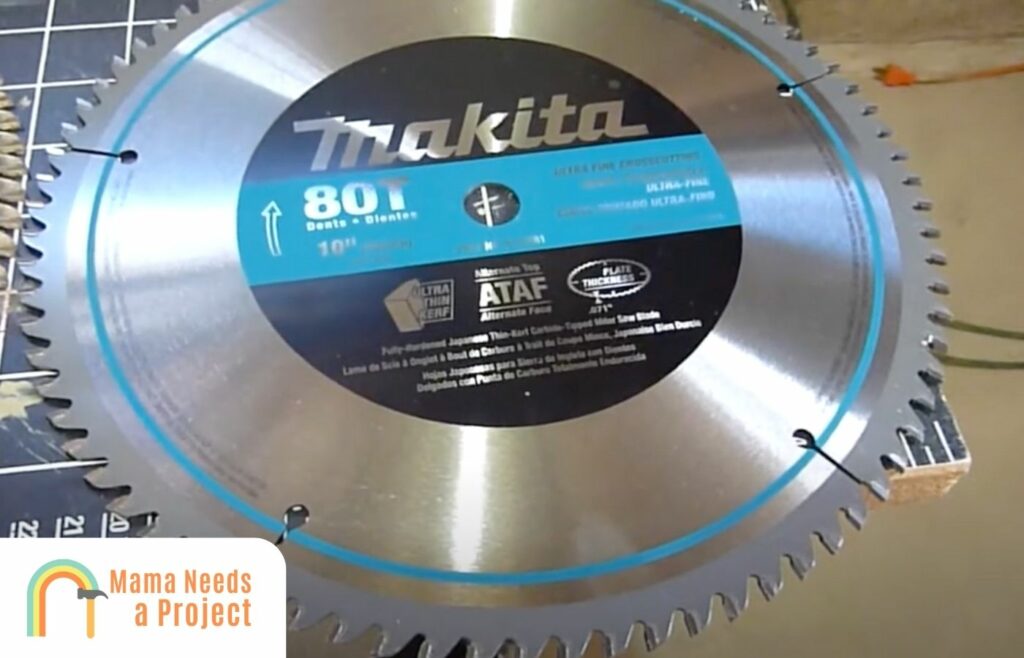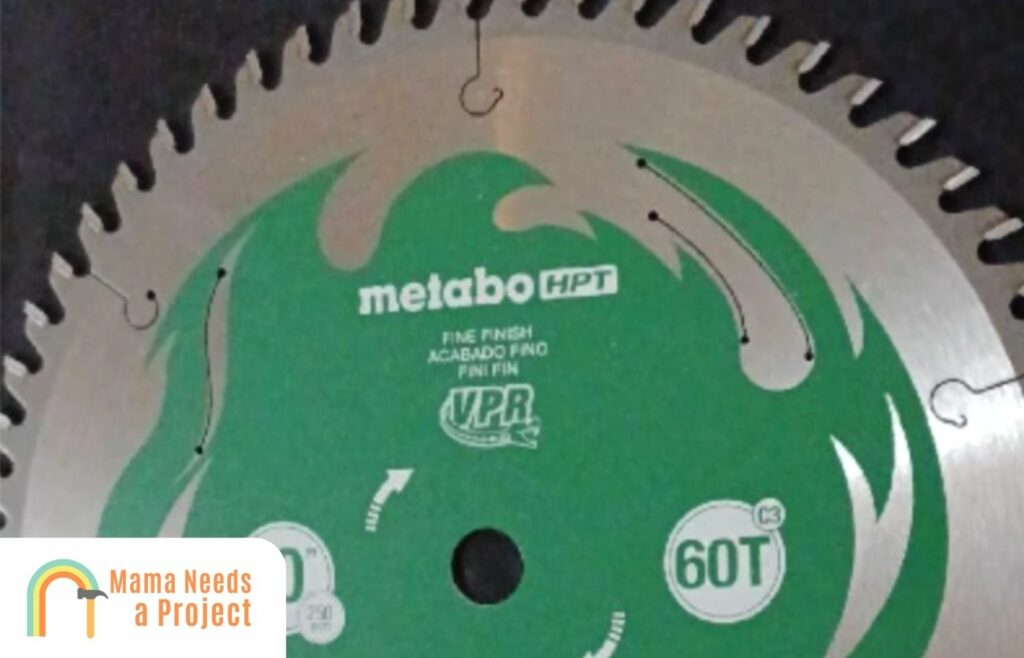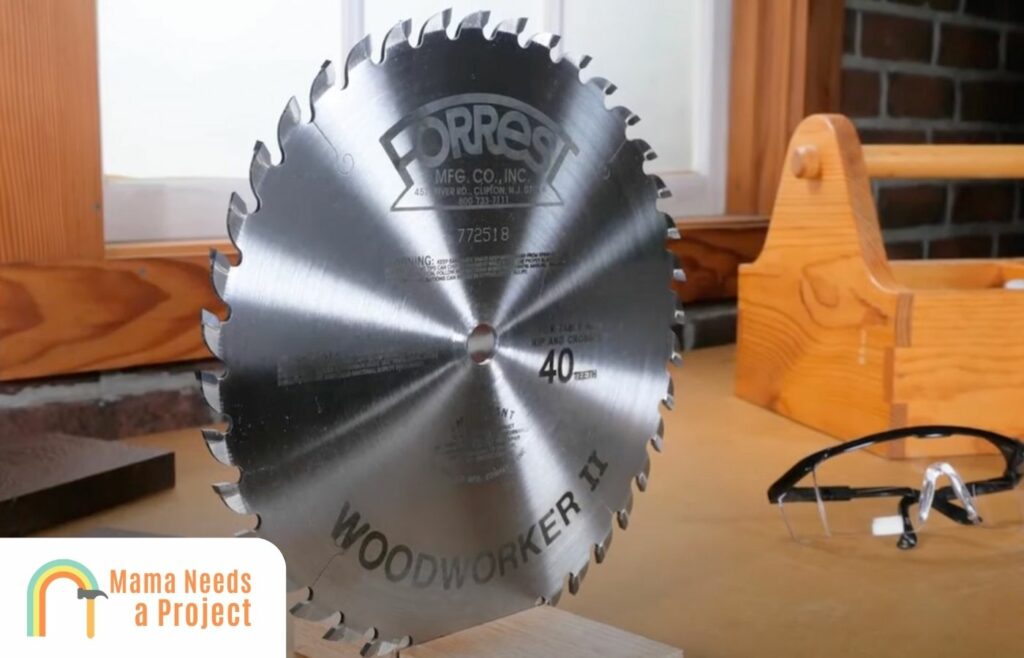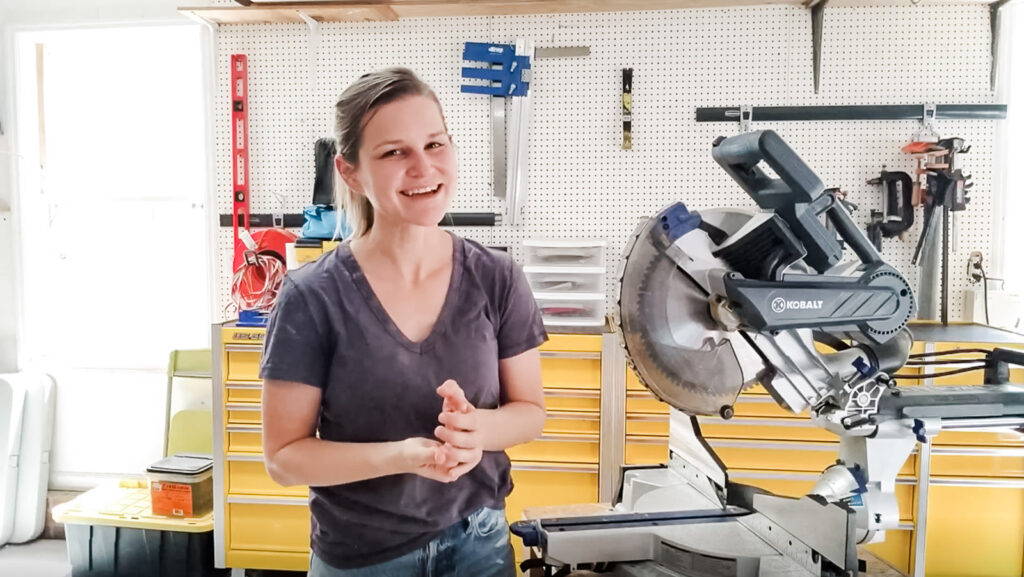5 Best Miter Saw Blades (Tested & Reviewed in 2024)
My miter saw is one of the most utilized tools in my woodshop – but it wouldn’t mean anything without an awesome blade.
The blade plays a big part in how accurate and clean your cuts are, which is why it’s so important to not cheap out on this piece.
In this post, I’ll show you some of the best miter saw blades you can buy so you can make the cuts you want. Let’s dig in!
In a hurry? The Makita A-93681 10″ Blade is the best miter saw blade because it’s well-designed, masterfully constructed, capable of delivering precise cuts consistently, and affordable when compared to other premium miter saw blades.
Quick Answer: Here are the Best Blades for Miter Saws! 👇
Best Miter Saw Blades
- #1 Best Overall – Makita A-93681 10″ Blade
- Highest Quality – Freud 10 in. 80 Tooth Ultimate Cut-Off Saw Blade
- Best Value – Metabo HPT 115435M
- Best 12″ Miter Saw Blade – Freud 100 Tooth Diablo Ultra Fine
- Best for Woodworking – Forrest Woodworker II 10-Inch Blade
1. Makita A-93681 10″ Blade – #1 Best Overall

- PRECISION : ATAF (Alternate Top and Alternate Face) tooth design for ultra precision cutting
- EFFICIENCY : Japanese ultra-thin kerf carbide-tipped design provides smoother cuts with less drag on the motor
- ACCURACY : Fully hardened and expertly hand-tensioned steel saw plates for true cuts
The Makita A-93681 10″ Blade is the best miter saw blade on my list because it’s built to last, less demanding, capable of achieving mirror edges, and affordable when compared to 10” miter saw blades of similar quality.
Thanks to a well-designed alternate top and alternate face (ATAF) tooth configuration and an ultra-thin carbide-tipped kerf, this 80-tooth miter saw blade can achieve precise, super-smooth cuts without straining your saw’s motor.
And in terms of durability, this blade is fully hardened and expertly hand-tensioned to ensure long-term accuracy, even when cutting dense materials.
This 10” miter saw blade has a 5/8” arbor hole, a plate thickness of 0.071”, and its max speed is 5,870 RPM.
What I Liked:
- Blade can quickly deliver mirror edges in various materials thanks to blade configuration
- Blade can make numerous cuts (5-6) in a short period without overheating
- Arbor hole is a perfect circle making it easy to mount and dismount
- 600-grit blade teeth ensure the blade doesn’t tear materials upon first contact
What I Didn’t Like:
- Blade can generate a particularly high-pitched screech when in operation
- Generates a lot of fine wood dust (which can reduce cutting accuracy)
My Thoughts
To put it briefly, the Makita A-93681 10″ Blade is the best miter saw blade overall because it combines durability and precision in a way other blades at this price can’t, and it’s both safer and easier to use than many blades designed for professional use. For the price, it’s a terrific buy, whether you make miter cuts routinely or every so often. Plus, it’s compatible with both table and miter saws which is great if you own both saws. My only complaints are the loud occasional screeching and the saw dust it produces – but these aren’t anything overly concerning. Overall – I highly recommend this blade and believe it’s one of the top miter saw blades you can buy.
Other Stores
2. Freud 10 in. 80 Tooth Ultimate Cut-Off Saw Blade – Highest Quality
- Specs: Arbor 5/8″, Diameter 10″, Grind ATB, Hook Angle 10°, Kerf .116″, Plate .098″, Teeth 80
- Freud’s exclusive blend of TiCo Hi-Density Carbide is specifically designed for each cutting application to maximize cutting…
- Alternate Top Bevel (ATB) 38-degree tooth with positive cutting angle
The Freud 10 in. 80 Tooth Ultimate Cut-Off Saw Blade is capable of delivering top-quality cuts time after time in a range of materials, mainly because it’s designed to be ultra-tough and extremely precise.
This 10” miter saw blade has a standard 5/8” arbor and a hook angle of 10°. The 80-tooth blade is 0.098” thick, and its kerf is 0.116”.
The teeth are tipped with Freud’s patented blend of TiCo Hi-Density Carbide, so it takes a while for the blade to wear down, no matter the materials you’re cutting.
Its alternate top bevel (ATB) 38-degree teeth ensure a positive cutting angle, and Freud’s patented Silver I.C.E Coating is employed so the blade resists overheating, rust, and corrosion better.
The blade’s strength is also a result of Freud’s proprietary Perma-Shield non-stick coating, which reduces blade drag and prevents build up of corrosive elements.
And thanks to anti-vibration tech, it’s easier to make precise cuts of all kinds.
Tri-Metal Brazing ensures the teeth are not only strong but flexible, which is why this blade doesn’t take off too much material upon first contact with a surface.
Lastly, thanks to Freud’s Hi-Tolerance Precision Plate Grinding & Tensioning, this steel blade resists warping even if performs more strenuous cutting tasks routinely.
What I Liked:
- Patented technologies & coatings ensure this blade lasts exceptionally long
- Blade can deliver mirror edges in softer materials despite being so tough
- Durability ensures you can make hundreds of cuts before sharpening is necessary
- Resistance to overheating ensures the blade can cut for longer (without interruption)
What I Didn’t Like:
- Much more expensive than other blades
- Solid red color makes it difficult to assess the extent of blade wear
My Thoughts
If quality miter cuts, bevel cuts, and crosscuts are what you’re after, consider the Freud 10 in. 80 Tooth Ultimate Cut-Off Saw Blade. This blade is one of toughest on the market right now, yet despite its toughness it’s still able to deliver precise mirror edges in softwoods, hardwoods, and other materials. Moreover, it can make hundreds of cuts before sharpening is necessary. The only thing I don’t like about it is its price. But if you’re looking for a quality blade, it’s well worth the additional money.
Other Stores
3. Metabo HPT 115435M – Best Value

- BLADE TYPE: Fine finish blade
- APPLICATION: Ideal for hardwood, softwood, high quality finish lumber, plywood and MDF
- TUNGSTEN CARBIDE: Industrial high performance micro grain tungsten carbide provides extreme durability and…
The Metabo HPT 115435M is an affordable yet highly capable miter saw blade, so it’s perfect for DIYers and hobbyists who don’t use their saw daily.
Laser-cut to ensure durability and precision, this blade can deliver crosscuts, miter cuts, bevel cuts, and even minor rip cuts in a range of materials.
Unlike the two blades above, this blade only has 60 teeth, but each tooth is tipped with tungsten carbide to ensure clean cutting no matter the task.
In fact, each tip is made using an automated grinding process, and this is why they’re able to strength the blade’s teeth to the extent they do.
The tips are also brazed so they remain durable even after first contact with denser materials.
And since the blade’s teeth are on the larger side, it’s easier to sharpen them – which can be convenient.
As far as vibrations go, this blade doesn’t generate a ton while in use, whether it’s fixed to a table or miter saw.
And unlike other saw blades, it isn’t prone to overheating, nor does it make a high-pitch screech while cutting – which is a bug plus.
It’s also rust-resistant thanks to an electrophoresis coating.
What I Liked:
- Cuts are consistently clean and smooth thanks to precision-ground teeth
- Sharpening doesn’t take long at all because teeth are relatively big
- Cost-effective purchase thanks to durability and low price
- Silver color makes assessing blade wear much easier
What I Didn’t Like:
- Teeth will dull faster if the blade frequently cuts dense material for an extended period
- Small size can make mounting on certain miter saws more difficult
My Thoughts
For a miter saw blade that’s priced affordably, the Metabo HPT 115435M is extremely capable. It’s built to withstand the strain of a variety of cutting tasks, and it can achieve mirror edges even though it has less teeth (60) than most 10” miter saw blades. And since it’s silver—not bright red or yellow—assessing blade wear is easy; sharpening is breeze too! However, it will get hot if it’s left to cut in dense material for an extended period, and its size can make mounting on certain miter saws challenging. Overall, if you want an affordable blade, this one is for you!
Other Stores
4. Freud 100 Tooth 12″ Diablo Ultra Fine – Best for Trim Work
No products found.
The Freud 100 Tooth Diablo Ultra Fine is ideal for trim work because its kerf is ultra-thin and its 100 teeth can quickly achieve mirror edges in both softwoods and hardwoods.
Like other miter saw blades, it’s laser-cut to ensure accuracy, and it has a 5/8” arbor so it’s compatible with most table and miter saws.
It utilizes a Parma-Shield nonstick coating so generated dust, gum, etc. don’t wear or slow it down, and its tri-metal shock-resistant teeth are braised so they don’t dull upon first contact with a dense material.
This blade can reach a max speed of 6,000 RPM, in part because it’s corrosion- and heat-resistant.
Tic Hi-Density carbide is employed to ensure cuts aren’t just clean but made quickly, and laser-cut stabilizer vents stifle vibrations and the sound of cutting.
In addition to wood, this blade can slice through composite surfaces and harder materials, like metal and reinforced plastic.
Moreover, it won’t kick back while cutting, and it doesn’t splinter thin edges like other miter saw blades which makes it more accurate.
But because there are so many teeth, this saw does tend to generate a fair bit of dust, regardless of the material being cut.
What I Liked:
- Affordably priced for a capable 12” blade as most are double what this one costs
- Isn’t much heavier than most blades despite being bigger making it easier to use
- Can make hundreds of cuts before sharpening is necessary so you can spend more time cutting
- Blade remains stable even after it’s been cutting uninterrupted for several seconds
What I Didn’t Like:
- Harder to assess the extent of blade wear because of solid red color
- Often too large for smaller workpieces because of the 12″ size
My Thoughts
If you’re looking for a 12″ miter saw blade, then I highly recommend the Freud 100 Tooth Diablo Ultra Fine, as its kerf, tooth-count, and overall design make it a fantastic miter saw blade for any job. Also, you can cut for several seconds without having to worry about wear, since this blade resists overheating super well. And whereas the other miter saw blades have 80 teeth or less, this one has 100, so its cuts are generally cleaner. My only gripe is that because of it’s size – it’s not as great for smaller jobs, but other than that this is a tremendous miter saw blade.
Other Stores
5. Forrest Woodworker II 10-Inch Blade – Best for Woodworking

- This kerf saw saves 1/8″ on wood loss for each cut.
- Feeds easily when used for moderate rips and crosscuts on a table saw
- Reduces jump in for better pull control
The Forrest Woodworker II 10-Inch Blade is a 40-tooth miter saw blade that’s ideal for woodworking, since it has a thin kerf (0.125), hand-brazed C-4 carbide teeth, and other amazing features.
It has a standard 5/8” arbor, and it’s hand-tensioned (up to 15 minutes per blade) to ensure it’s strong and precise no matter the wood it’s cutting through.
It’s compatible with table and miter saws, and it can make crosscuts, bevel cuts, miter cuts, and rips cuts in softwoods and hardwoods up to 2” thick.
Since it only has 40 blades instead of the normal 80, it’s more prone to tearing. Still, when this happens, the tear is almost always negligible so it’s not a huge deal.
At just 2.18 lbs, this blade is 11” x 11” x 1”, silver, and easy to store.
Plus, it has a 30° alternative top bevel and a 5° face hook to ensure stability and precision while cutting.
Lastly, the manufacture offers a free blade sharpening service and there’s a 30-day money-back guarantee – which speaks to its quality.
What I Liked:
- High-grade, anti-stick steel ensures this blade can cut naturally moist woods
- Silver color makes wear easy to spot
- Compatible with most table saws and miter saws
- Free blade sharpening can elongate a blade’s lifespan significantly
What I Didn’t Like:
- Takes longer to cut denser materials because there aren’t as many teeth
- More expensive than other blades
My Thoughts
For a 40-tooth 10” blade, the Forrest Woodworker II 10-Inch Blade is incredibly precise, whether it’s cutting through dense oak or thin pine. If any cutting marks are left, they’re negligible. This blade is built to last and boasts several blade features that ensure it’ll remain precise and tough even after hundreds of cuts. Sure, it takes longer to cut because it has less teeth, but its high price is the real drawback. Still, Forrest backs up their quality, so the price is easily justified in my book. If you’re looking for a high quality blade that’s perfect for woodworking – this is the blade for you!
Other Stores
What to Consider When Buying a Miter Saw Blade

Material
The material a miter saw blade is made of not only determines its strength but its precision as well. Most miter saw blades are made of high-grade steel, since it wears slowly, rarely warps, and naturally resists rust and other erosive elements.
But it’s worth pointing out that even a lower-grade, mixed-metal material could hold up well over the long term if it’s been coated with a corrosion-resistant, life-extending substance.
Furthermore, the best miter saw blades have carbide teeth as well, since carbide tips eliminate rough edges and speed up the cutting process.
Tooth Count
The number of teeth a miter saw blade has is important as well. Most 10” miter saw blades have 80 teeth, while some have 60 teeth or even less. The 12” blades have 100 or more teeth.
Basically, the more teeth there are, the cleaner the cuts will be. Also, more teeth means a quicker cutting process.
However, just because a blade doesn’t have 80+ teeth doesn’t mean it can’t achieve clean, accurate cuts.
Some of the best miter saw blades have 40-60 teeth, and they can do what 80-tooth blades do because they’re thinner blades with reinforced carbide teeth.
In other words, quantity doesn’t always guarantee quality.
Looking to make dado cuts? Check out these top rated dado blade sets!
Blade Size
Blade size should be considered, of course, but it’s not as important as most of the other factors discussed here.
Most miter saw blades are 8″-12″, with 10″ blades being the most popular.
Some people use the term “blade size” to refer to a miter saw blade’s thickness, but this is more commonly known as kerf width.
Generally speaking, blades with a smaller diameter are better for smaller workpieces and vice versa.
Kerf
“Kerf” refers to cut thickness, so it’s one of the most important aspects to consider when choosing a miter saw blade.
Blades with a thin kerf tend to be great for making bevel cuts and other intricate cuts, mainly because they don’t rapidly take off too much material.
Most miter saw blades have a kerf that’s around 1/8″.
Durability & Construction
The way a miter saw blade is constructed largely determines its effectiveness and lifespan.
There, a miter saw blade that’s been hand-tensioned and hand-brazed is going to perform better over the long term, especially if it’s been coated and outfitted with certain technologies.
Looking for other miter saw accessories? Check out these top rated miter saw stands!
Heat & Corrosion Resistance
There may be times when you need to make a number of miter cuts in a short period, and when these times come it’s best to have a miter saw blade that can resist overheating and corrosion.
Carbon-steel blades don’t heat up as fast as other materials, but even they aren’t impervious to overheating.
Essentially, if you want to ensure a long blade life, you shouldn’t frequently put your miter saw blade in a position where it could overheat.
Corrosion resistance is helpful too, but only if your blade is exposed to an excessive amount of moisture, either during cutting or outside operation.
Price
At the low end, a quality miter saw blade is going to run you $35-$50, while top-of-the-line blades cost $85-$150.
Several factors determine blade price, such as the number of teeth, the material used to make the blade, the intricacy of the design and construction processes, the brand, and the level of demand for the product.
Dust Generation
Dust generation is an inextricable part of the sawing, but a miter saw blade with a higher tooth count is more prone to generate an excessive amount of fine dust.
And a brand new miter saw blade is going to generate far more dust than one that’s had some time to wear, so consider this before you start cutting with a new blade.
Compatibility
A miter saw blade that’s compatible with both table saws and radial-arm saws may be a smart buy if you own both saws. This way, you can still make cuts if one saw goes down.
Wondering how to change your miter saw blade? Check out the video below!
Color
Silver blade plates are best, as they’re easy to assess when you need to gauge the extent of blade wear.
Compare these to Diablo blades, which are solid red and therefore harder to check for wear.
Final Thoughts
To recap, the best miter saw blade is the Makita A-93681 10″ Blade because it can consistently deliver superior cuts in a range of materials without wearing down, yet it’s half the cost of miter saw blades that offer similar capabilities.
In terms of quality, the Freud 10 in. 80 Tooth Ultimate Cut-Off Saw Blade is superior, since it employs a handful of technologies and coatings to ensure it delivers mirror-smooth cuts consistently.
The Metabo HPT 115435M offers the best value, since it has tungsten carbide-tipped teeth, an alternate top bevel, and a few other features that high-end miter saw blades boast.





